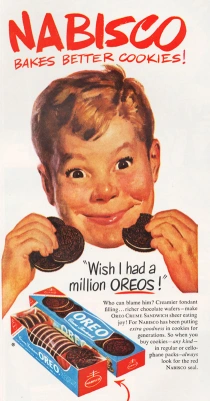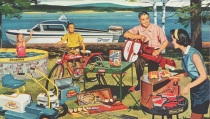
The winking “curiosity” between the two men in the “I was Curious” ad makes it one of the most famous homo erotic ad campaigns ever. Vintage ad Schlitz Beer 1946
I’m curious.
How’s your mid-century gaydar?
If it doesn’t go off checking out these series of vintage advertisements, it needs some fine tuning.
During the same post war period as the film Carol recreates, Madison Avenue captured that same curious culture of concealment and conformity with a series of sexually ambiguous ads, winkingly called “I Was Curious.”
Running from the late 1940s through the early 1950s, one of the most famous homo-erotic ad campaigns was put out by the beer that made Milwaukee famous, Schlitz.
At a time when conformity was compulsory, clandestine encounters between same-sex individuals were conducted with great caution, and one’s Gaydar had to be finely tuned or face the consequences. When romantic interest was expressed it was done in a circumspect coded and cryptic way.
While these ads ran in the late 1940s homosexuality or sexual deviancy as it was affectionately called, was condemned on all fronts. Psychiatrist considered it a serious mental disorder that needed to be treated and nearly every state had laws criminalizing it.
I Was Bi Curious
The formulaic ads consisted of two heterosexual couples gathering socially, happily imbibing in a beer. But the veiled “curiosity” between the two husbands is expressed with coy, knowing glances as their mid-century gaydar goes off.
Whether the setting was a lakeside picnic, a ski lodge, or a suburban living room, by the third panel of the illustration, nary a woman is present as the men gaze adoringly into each others eyes.
Is it any wonder that in the film Carol, her love interest Theresa is often seen drinking Schlitz throughout the movie?

Even wives could be seen flirting with coquettish kittenish teasing glances. Vintage ad Schlitz Beer 1949
© Sally Edelstein and Envisioning The American Dream, 2016. Unauthorized use and/or duplication of this material without express and written permission from this blog’s author and/or owner is strictly prohibited. Excerpts and links may be used, provided that full and clear credit is given to Sally Edelstein and Envisioning The American Dream with appropriate and specific direction to the original content.




















Many might say that we are reading into this. But we all know that many of the artists and account “pitchers” were closeted gay men. They knew exactly what they were doing. there is no mistaking the body language in the panels
LikeLiked by 1 person
Do I think a mid century matron from Mammaroneck or her harried husband might read these ads in this way? Doubtfully. But viewing them though a contemporary lens, it’s hard to discount the subtle subtext.
But you are right about the “pitchers.” Mad Men’s Bob Benson wasn’t the only closeted gay man in advertising. The real mad men of Madison Avenue produced many real ads with home erotic subtext.
Marketers have long used ambiguity as a way to tap the gay audience without alienating others. The term in adverting circles is “gay vague” -ads in mainstream media with subtle gay context that heterosexuals tend not to register and steer clear of any backlash.
Nowadays advertising and marketers are moving beyond “gay vague” to specific gay imagery even as they aim at the wider gay supportive audience. As more brands are targeting gays there will be less “coding” as the walls of the corporate closets are falling one by one.
LikeLike
Very interesting.
LikeLiked by 1 person
I love this series. Check out the arrow shirt and socks ads by JC Leyendecker for some even more blatant homoeroticism earlier in the 20th century…
LikeLike
I think this is humorous, fascinating, and possibly real homoeroticism. But I’m not 100% convinced. After all it was a different time. And it’s not fair to judge a different time through our contemporary lense, as you say.
LikeLike